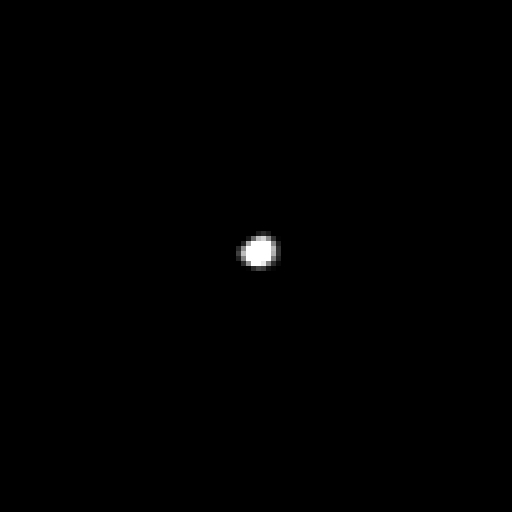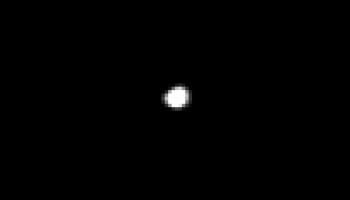Rosetta’s scientific imaging system OSIRIS is slowly but surely resolving comet 67P/Churyumov-Gerasimenko in its narrow angle camera (NAC), giving the first tantalising hints of its shape.

Rotating comet 67P/C-G, 27-28 June 2014.
Credits: ESA/Rosetta/MPS for OSIRIS Team MPS/UPD/LAM/IAA/SSO/INTA/UPM/DASP/IDA
The comet covers about four pixels in this image, which was taken on 28 June from a distance of about 86 000 km. The accompanying movie, comprising 36 images taken with the NAC on 27-28 June, shows the comet nucleus spinning with a rotation period of 12.4 hours.

Comet on 28 June 2014
Credits: ESA/Rosetta/MPS for OSIRIS Team MPS/UPD/LAM/IAA/SSO/INTA/UPM/DASP/IDA
The comet appears – as expected – rather fuzzy from this distance and seemingly covers a slightly larger area than two by two pixels. This is due to the physical effects of the way light is spread inside the imaging system, and is not associated with the comet displaying a coma, for example.
These imaging effects won’t be noticeable once Rosetta is closer to the comet and able to capture the high-resolution images we have all been anticipating. Indeed, there isn’t long to wait before we see what these four pixels are hiding: within the next two weeks the comet will cover an area of 20 x 20 pixels in the NAC.
Today, 3 July, Rosetta is at a distance of about 43 000 kilometres from comet 67P/C-G, and by the end of the weekend will be less than 36 000 km – equivalent to the altitude that geostationary satellites orbit Earth.
Yesterday Rosetta completed the fifth in a series of ten rendezvous manoeuvres required to ensure the spacecraft’s arrival at the comet on 6 August.
Almost there!









Discussion: 9 comments
Looking forward to unveil more detail of 67P/C-G
Thank you for these pictures. This is exactly the kind of information I’ve been looking forward for.
I second that 🙂
As a layman.
Does the craft have to approach the nucleus of the Comet tangentially to avoid the wake debris? Seems to me less fuel than would be used manoeuvring every which way
Good comment. I suspect the Rosetta needs to be pointed in a particular direction for navigation and tracking purposes.
I must admit, those huge solar arrays so close to an active comet does worry me a little.
Hi, yes indeed it tries to avoid the tail. Check out this animation to see the trajectory of the spacecraft after arriving in August: https://www.esa.int/spaceinvideos/Videos/2014/01/Rosetta_s_orbit_around_the_comet
Amazing already, well worth remembering the nucleus is only approx. 4 KM wide and already the OSIRIS NAC is starting to resolve the shape.
I hope we get to see some more images over the next few days.
The repeating pattern of the shape of the nucleus suggests to me that there is a concavity, perhaps much like the Massilia Basin on the Main Belt Asteroid 21 Lutetia.
Obviously scaled down as the nucleus of 67P/Churyumov–Gerasimenko is only about 4% of the size of the huge asteroid that Rosetta successfully encountered in July 2010 in spectacular fashion.
Please show images as soon as you can, perhaps a raw images site much like the NASA MER B Opportunity, MSL Curiosity and Cassini sites do.
Another dumb question Andrew,
Seems to me that the comet’s width/length ratio (4/100km) is a bit odd.
Where is all that mass in such a small width to feed a constantly evaporating tail this long?
Again, Voyager didn’t need to rotate back to align it’s antenna to earth Rosetta will have to be doing this to communicate with us. Reason?
Well, Voyager is powered by RTG no solar panel to face permanently to the sun. Rosetta must additionally turn the antenna to the earth and the scientific instruments to the comet… She must be a contorsionist !!